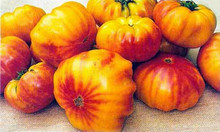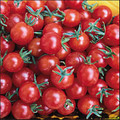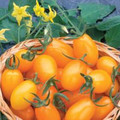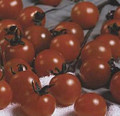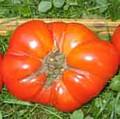 Loading... Please wait...
Loading... Please wait...- Home
- Tomato Seeds
- Virginia Sweet Tomato Seeds
Product Description
Virginia Sweet Tomato Seeds
20 Seeds per packet
Bicolor yellow and red, sweet yellow flesh, 1 pound or more, great taste.
Indeterminate
80 days
CULTURE GUIDE
Lycopersicon esculentum
CROP HISTORY AND DEVELOPMENT
Wild type tomato species are thought to be native the region of western South America and specifically in the dry coastal desert of Peru. First historical reference in Europe to the tomato was a yellow fruited type in Italy in 1544, cultivation in Germany in 1553. The Italians may have acquired it from the Turks. The tomato may have first been grown in Spain then taken to Italy where it was called "pomi d'oro" or golden apple, because of its yellow color. The French called it "poma amaris" or apple of love. The American Indians used the name "tomatl."
The tomato was not very popular until the 18th century mainly because of rumors that had labeled it as a poisonous fruit. It is suggested that certain famines during this century forced people to try this plant, because by the middle of the century the tomato was much more popular.
The tomato was introduced into the United States in 1710. By 1779 it was used in catsup in New Orleans. Thomas Jefferson grew tomatoes in Virginia. But as late as 1900 the tomato was still considered poisonous. George Washington Carver was known for standing in front of crowds and eating tomatoes, trying to introduce tomatoes into the diet. The tomato originated in South America due to the wild species found from Ecuador to Chile. This means the tomato traveled from South America to Europe before arriving in the United States. L. esculentum is probably derived from Lycopersicon pimpinellifolium which is indigenous to Peru and Ecuador. L. esculentum var. cerasiforme (cherry tomato) is considered a wild plant in the tropics and subtropics. There is also evidence that tomatoes originated in Mexico. These tomatoes show a great diversity in size and shape and include all color types known which are pink, red, and yellow. The cherry tomato is widely used in Mexico and has many Indiana names. The Nah uatl language of Mexico used the name "tomatl" which has followed the plant through Europe and South America. Mexico would be a logical origin since Cortez conquered Mexico in 1519, tomatoes could have easily found their way to Italy by 1544. There are still arguments as to the origin of the tomato.
PLANT CHARACTERISTICS
Root System. The root zone of tomato can extend outward and downward up to 5 feet. The depth of the tap root depends upon soil and cultural practices (harvesting tomato transplants for replanting generally damage the tap root, making these tomato plants dependent upon a fibrous root system in the upper 6 to 10 inches of the soil). In cross section, the xylem forms a cylinder in the center of the root, with two lateral wings. The phloem completes the vascular tissue, filling out the space between the wings and forming a cylinder. This is surrounded by a single layer of pericyclic cells to form the protostele which is surrounded by an endodermis, a three to four layered center and an epidermis. Lateral roots arise from the pericyclic cells and grow through the cortex. The xylem is usually tetrarch. Stem. The stem is typically about 4 cm in diameter at the base and is covered with glandular and nonglandular hairs that when touched stain the hands greenish black and give a characteristic tomato smell. There are phloem strands both inside and outside a tube of xylem fibers which surround a core of pith cells. As secondary phloem develops, the outer phloem forms a more continuous cylinder Secondary xylem is more developed in thin, slow growing stems rather than thick rapidly growing stems containing larger pith cells. The whole vascular structure and the pericycle form the siphomastele. The siphomastele is surrounded by the cortex which contains the endodermis, collenchymatus cells and photosynthetic cells, immediately under the epidermis.
At the top of the main stem is the apical meristem. It is dome shaped and is protected by newly formed leaves. This is where new leaves and flower pairs are initiated. Between 7 and 11 leaves are formed before the apex becomes a terminal inflorescence. Further growth is from the leaf axils developing like the original axis. Indeterminate cultivars produce inflorescence every three leaves, whereas determinant cultivars produce a limited number of inflorescence on each axis and strong axillary buds develop on the base of the stem producing a bushy appearance.
Leaf. The size of the compound leaf is variable. The lowest leaves are small with few leaflets. Leaves thereafter can be up to 0.5 meters long with up to eight lateral leaflets. Smaller leaflets are interspersed with large leaflets. The leaves are covered with hairs of the same types as on the stem.
Fruit. Botanically, a tomato fruit is a berry consisting of seeds within a fleshy pericarp developed from an ovary. Fruits of L. esculentum have two to several carpels. There is extreme variability of fruit characters such as size, shape, exterior color of mature and immature fruit, and interior flesh color.
Tomato Seed Seed. The seed of a commercial cultivar is a flattened ovoid, up to 5 mm long, 4 mm wide and 2 mm deep, consisting of the embryo, endosperm, and testa. The embryo consists of the radical, hypocotyl, two cotyledons and the short apex. The testa is covered with large soft hairs which tend to bind with other seeds.
PROPAGATION METHODS
Overview. Tomatoes can be direct seeded or transplanted as seedlings. Direct seeding is used if soil moisture and temperature favor rapid germination and if mechanical harvesters are used. "Pop-up" fertilizers, placed two inches to the side and two inches below the seed, may be used to provide nutrients for a more even, rapid germination. Precision seeders place three to six seeds at desired spacing. One to three of the seedlings generally develop in one clump. These seedlings are either thinned or left to develop. Thinning generally doesn't affect yield per acre. Seeding rates per acre varies from 56,000-192,000.
Tomato growers with a shorter growing season and most home gardens employ tomato transplant seedlings. These are mostly grown in the southeast (Georgia and Florida). These transplants are four to six inches tall and are four to six weeks old before being harvested for transplanting. Transplants per acre will vary from 5,445 (24" x 48") to 14,520 (12" x 36").
CULTURAL PRACTICES
Overview. The tomato is a warm season perennial cultivated as an annual. The tomato is day neutral but requires a day to night temperature change of at least 10°F during long days to be productive. Production Area Since 1900 the tomato has become the second most important vegetable crop with the white potato being number one. In the U.S. over eight million tons are produced annually. Seven million tons were processed (soups, juice, catsup, sauce, whole tomatoes and prepared foods) and over one million tons were sold as fresh tomatoes. This does not include considerable amounts of tomatoes grown in home gardens. Ninety-three percent of the 33 million gardens in America grow tomatoes with this number of homes cultivating a garden
The leading commercial fresh market producing states are Florida, California and South Carolina. The leading processing states are California, Ohio and Indiana. California produces 84% of tomato fruit used for processing.
Cultivars A representative list of tomato cultivars and their use are listed in the following table. They are divided up by whether they are for processing (paste, table or pickling) or for fresh market (field grown or greenhouse grown).
Both processing and fresh market tomatoes can either be determinate or indeterminate. A determinate will set fruit at the terminal bud and growth stops. Harvest time for determinate is short; sometimes only a week to ten days. An indeterminate does not set fruit at the terminal bud. The growing point produces leaves and more stem. Harvest time may last for months and the vine will travel extensively over the ground if allowed to grow in this manor.
Establishment: Tomatoes do very well on most mineral soils, but they prefer deep, well drained sandy loams. Deep tillage can allow for adequate root penetration in heavy clay type soils which allows for production in these soil types. Soils extremely high in organic matter are not recommended due to the high moisture content of this media and nutrient deficiencies. But, as always, the addition of organic matter to mineral soils will increase yields.
Fertility: Tomato is a moderately tolerant crop to a wide pH range. A pH of 5.5- 6.8 is preferred though tomato plants will do well in more acidic soils with adequate nutrient supply and availability. Calcium availability is also very important to control soil pH and nutrient availability. Soil and tissue analyses should be taken throughout the growing and production season to insure essential nutrients are in their proper amounts and ratios. Mono Ammonium Phosphate (MAP) may be used as a starter fertilizer to supply adequate phosphorus during germination and seedling stages. Sandy soils will require a higher rate of fertilizer, and more frequent applications of these fertilizers due to increased leaching of essential nutrients. Tissue analysis of a nutritionally sufficient plant will show the following:
N P K Ca Mg S
% 4.0-5.6 0.30-0.60 3.0-4.5 1.25-3.2 0.4-0.65 0.65-1.4
ppm Mn Fe B Cu Zn
30-400 30-300 20-60 5-15 30-90
Probably, the most common nutritional problem with tomatoes is with calcium deficiency. Blossom end rot is caused by a lack of calcium, water or both. This leathery scar on the blossom end of the berry is a product of insufficient calcium in the berry. Water is required to move the calcium into the berry, which is where drought comes into play. Adequate calcium, early in berry development, is essential to tomato production. Ninety percent of the calcium requirements for adequate fruit development must be in the fruit prior to the formation of a wax covering over the surface of young fruit.
Irrigation : Tomatoes have been observed to withdraw water from depths up to 13 feet in a well structured soil. Tomatoes are a heavy water user and require frequent irrigation to delay maturity and prolong plant productivity. Soil moisture levels should never exceed two bars.
Erratic moisture conditions can cause radial and concentric cracking on fruit. This is a serious physiological disorder that leave the affected tomatoes unmarketable and quickly deteriorating. Cat facing, blossom scar and puffiness can be related to soil moisture variability.
INSECTS
Tomatoes are subject to a large number of pests from the time plants first emerge to harvest. Aphids, flea beetles, leaf miners, and spider mites are a problem to plant bed tomatoes. Flea beetles, aphids, leaf miners, stink bugs and fruit worms cause foliage damage in the field. But their fruit damage and disease spreading problems can be very serious.
These pests are divided into two groups: pests that feed on the upper plant and pests that feed on the lower plant.
The upper plant feeders either mine leaves, bore into fruit and buds, chew holes in leaves or are sap suckers. The pests that mine leaves or bore into fruits and buds are the fruit worm, bud worm, pinworm, and leaf miner. The pests that chew holes in leaves are the blister beetle, cabbage looper, Colorado potato beetle, flea beetle, and horn worms. The sap suckers are the green peach aphid, potato aphid, greenhouse white fly and stink bug. These sap sucking insects can transmit disease and cause fruit drop.
The lower plant and root feeders are the cutworm and the wire worm. The controls vary from state to state and region to region. The local agricultural chemical manual will list controls and rates for each pest.
DISEASES
There are many disease pests of tomato including bacteria, fungi, and many viruses.
The bacterial diseases include:
Bacterial wilt (Pseudomonas solanacearum) is a soil borne bacterium which infects the roots and stem of the plant causing a sudden wilt. disease. Crop rotation and sanitation are controls for this.
Bacterial canker (Corynebacterium michiganense) is a seed borne bacterium in which cankers form on the stems and petioles. Light halos may also form on the berry. Disease free seed is the best control for canker.
Bacterial speck (Pseudomonas syringae) is a problem in moist weather. Dark green halos on fruit characterize this disease.
Bacterial soft rot
Fungal diseases include:
Fusarium (Fusarium oxysporum f. sp. lycopersici) and Verticillium (Verticillium dahliae) wilts are fungal vascular diseases. Verticillium is most severe in the north and Fusarium is most severe in the south. Resistant cultivars are the most effective controls of these diseases.
Early and late blights (Alternaria solani and Phytophtora infestans respectively) have similar problems as with potato. Both are controlled with fungicides.
Anthracnose (Colletotrichum phomoides) is shown by its sunken spots on the fruit. Rotation is the major control for this disease.
Virus diseases such as tobacco mosaic, curly top and spotted wilt are problems that only sanitation, weed and insect control can keep in check. There is resistance for tobacco mosaic and curly top viruses.
HARVESTING
The harvest of tomatoes is dependent on the closeness to the market. Local sale of tomatoes may be vine ripened to a firm ripe or a full red color before harvesting. Those picked to be shipped are picked at the mature green stage and sprayed with ethylene 48 hours prior to shipping. Tomatoes for the fresh market are generally hand picked.
Processing tomatoes are picked fully ripe. The harvesting is a completely mechanized one time event. The plants are cut at the ground level and mechanically shaken to remove the fruit which is then washed and processed.
POST HARVEST
Full ripe tomatoes are stored at a temperature of 55°F for up to several days. Temperatures cooler than this will cause chilling injury, producing poor colors and off flavors. In processing, tomatoes must have a pH below 4.5 to retard botulism.
Mature green fruit are bulk packed in ventilated containers for shipment. Upon arrival they are repackaged and covered with cellophane and sold.








